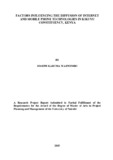| dc.description.abstract | This research study was undertaken to investigate the factors influencing the diffusion of Internet and Mobile Phone Technologies in Kikuyu Constituency, Kiambu County. The study was carried out in Thogoto Sub-location - one of the administrative sub-units of the constituency. The overall purpose of the study was to provide an informative combination of explanations that can be readily applied and generalized on the Constituency’s ICTs uptake trends which could be applied, inter alia, in deployment of services on the basis of predicted diffusion rates or even hasten the diffusion of services already rolled out. To achieve this goal, there were four objectives that guided the research process. These were: to establish how the accessibility of the Internet and mobile phone technologies influence their adoption and usage rates in the Constituency; to assess the influence of social demographics on the adoption and usage rates of the Internet and mobile phone technologies in the Constituency; to investigate the influence of theoretical innovations’ adoption-diffusion factors on the adoption of the Internet and mobile phone technologies; and to investigate the influence of theoretical innovations’ use-diffusion factors on the use of the Internet and mobile phone technologies in the Constituency. The research design adopted a descriptive survey approach. The target population comprised of 15,897 persons – the projected population for Thogoto Sub-location that was 5 years and older in 2013 – and a combination of cluster and random sampling was employed to identify the 375 respondents sampled. The questionnaire used to capture respondents’ data was scrutinized for face and content validity before being administered. Data collected was found to be reliable through statistical test that gave 0.86 Cronbach alpha value. The independent variables in the study were tested for their influence on the dependent variable using various statistical tests including binary, multinomial and ordinal regression tests. It was found that mobile phones had been adopted by all respondents involved in the survey. Adoption of Internet technologies was found to be significantly influenced by accessibility factors, social demographics as well as the other theoretical adoption constructs. Furthermore, it was found out that among the adopters of Internet and mobile phone technologies, their corresponding rates and variety of usage of the technologies could be significantly be explained by the innovations’ use-diffusion constructs of the Use-Diffusion model (Shih & Venkatesh, 2004). The segmentation of the users against the fourfold use-diffusion patterns defined by the 2 X 2 matrix of usage-variety vs usage-rate was also found to be significantly explained by the Use-Diffusion constructs of product experience, complementarity and social communication. In conclusion it was found out that accessibility, social demographics as well as adoption- and use-diffusion factors all played part in influencing the uptake of ICTs in the study area. Among the recommendations emanating from the discussions of the research study findings is the need to improve accessibility to computing devices other than mobile phones as well as the need to factor the social demographics of age and education levels in choosing the information communication platforms for service delivery. Further studies can improve on the research approach by striving to develop a unified-factor model that combines accessibility factors and the social demographics together with the existing theoretical constructs as all these were found to be significantly responsible for diffusion trends. Areas of further studies that can be zeroed in to provide more elaborate data could include studies based on specific age groups or even occupations. Future studies could also include the use of IPTVs and digital TVs which are other communication platforms gaining popularity in the country. It is envisaged that the findings will better inform ICT policy-making within the constituency and, by extension, within the larger Kiambu County that consists of eleven other constituencies. | en_US |

